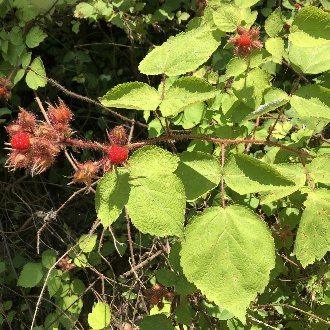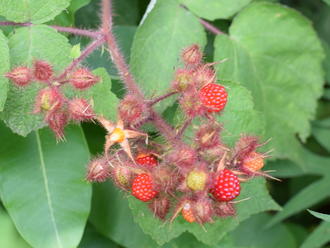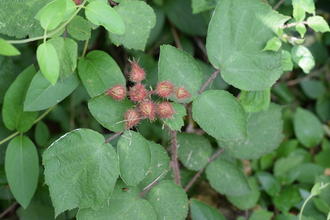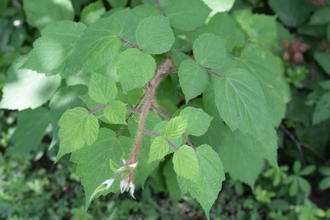Wineberry (Rubus phoenicolasius Maxim.)
↑Summary
A raspberry with arching distinctive red hairy stems. Native to East Asia; introduced in Eastern North America and widely considered invasive. Similar in growth habit and habitat requirements to native Rubus occidentalis, but easily distinguished visibly by its hairy red stems.
↑Range - Expand
| Legend | Color |
| Introduced | |
| Introduced or Not Present |
This tentative map is based on our own research. It may have limited data on Canada and/or Mexico, and there is some subjectivity in our assignment of plants as introduced vs. expanded. Read more in this blog post.
Although this plant occurs somewhere in each of these regions, it may only occur in a small part of some or all of them.
↑Habitat
In its native range in East Asia, this species is mostly found along montane valleys, streams, and bottomlands in mountainous areas. It is also common along roadsides.
The habitat requirements of this species in North America are not fully understood. Habitat preferences are similar to the native black raspberry (Rubus occidentalis), and both species often co-occur in the same habitats where their range overlaps. With the exception of one site in California, this species has only established within the interior of the range of the native black raspberry, and has not yet been reported in the more northerly, southerly, or westerly portions of that species range, which suggests that this species may have a narrower range of climactic tolerances.
It is found in a variety of habitats, including early-to-mid successional stages of forests, floodplain forests, more open bottomland habitats, wetlands, and edge habitats, including roadsides and various disturbed habitats.
Prefers full sun, but can tolerate partial shade. Absent from densely shaded habitats. Periodic drought may limit its occurence on drier sites.
Humans have created a lot of the edge habitats where this species thrives.
↑Life Cycle
Rubus phoenicolasius is a perennial plant with characteristics of a shrub, vine, and biennial. It produces "first year canes" both from seed and vegetatively, which initially grow upright but soon start arching. This plant will take advantage of the structure of other plants, growing taller with support from other vegetation, but stems will eventually grow back towards the ground, where they usually root. First year canes do not flower and fruit.
The plant then goes dormant, and second year canes leaf out, at the same time as new first year shoots form from the places where the previous year's canes rooted, as well as the original roots. Often, a clump of several stems will arise from each area of rooting, and the stems will arch in different directions. These shoots are usually much more vigorous and reach greater size than first-year plants germinating from a seed.
Second year canes flower and fruit, after which they die.
Fruits are eaten and the seeds thus distributed by both birds and mammals. This plant blooms and sets fruit later than the native Rubus occidentalis, with which it often co-occurs.
↑Uses
This plant was originally introduced as breeding stock for creating new raspberry cultivars. People gather and eat the fruit, which is usually consumed fresh. Fruit are slightly firmer, tarter, and somewhat blander than standard red raspberries, although less firm and generally less flavorful than the native black raspberries (Rubus occidentalis).
↑Related Plants
The native black raspberry (Rubus occidentalis) is closely related to this species, and hybrids have been intentionally formed, although no natural hybrids have been reported.
This species is grouped in the Idaeobatus subgenus (raspberries, fruit which separate from the receptacle in a cup shape), and is more closely related to raspberries than to other types of Rubus, such as blackberries. Numerous examples of both native and introduced raspberries also occur in North America.
↑Links & External Resources
• Wine Raspberry | Fire Effects Information System (FEIS) (About This Site)
• Rubus phoenicolasius (Wineberry) | USDA PLANTS Database (About This Site)
• Rubus phoenicolasius | Go Botany (About This Site)
• Wine Raspberry | Virginia Tech Dendrology Factsheets (About This Site)
• Rubus phoenicolasius | Biota of North America Project (BONAP) (About This Site)
• Rubus phoenicolasius | NatureServe Explorer (About This Site)
• Rubus phoenicolasius | Flora of North America (About This Site)
• Wineberry | Maryland Biodiversity Project (About This Site)
• Rubus phoenicolasius Maxim. (Wineberry) | Digital Atlas of the Virginia Flora (About This Site)








